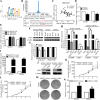ARNTL hypermethylation promotes tumorigenesis and inhibits cisplatin sensitivity by activating CDK5 transcription in nasopharyngeal carcinoma
- PMID: 30621723
- PMCID: PMC6325889
- DOI: 10.1186/s13046-018-0997-7
ARNTL hypermethylation promotes tumorigenesis and inhibits cisplatin sensitivity by activating CDK5 transcription in nasopharyngeal carcinoma
Erratum in
-
Correction to: ARNTL hypermethylation promotes tumorigenesis and inhibits cisplatin sensitivity by activating CDK5 transcription in nasopharyngeal carcinoma.J Exp Clin Cancer Res. 2022 Jan 21;41(1):30. doi: 10.1186/s13046-021-02238-5. J Exp Clin Cancer Res. 2022. PMID: 35062998 Free PMC article. No abstract available.
Abstract
Background: Increasing evidence support an important role for DNA methylation in nasopharyngeal carcinoma (NPC). Here, we explored the role of circadian clock gene Aryl Hydrocarbon Receptor Nuclear Translocator-Like (ARNTL) methylation in NPC.
Methods: We employed bisulfite pyrosequencing to determine the epigenetic change of ARNTL in NPC cell lines and tissues. ARNTL mRNA and protein expression in cell lines and tissues were detected by real-time PCR and western blotting. Then, we constructed cell lines overexpressing ARNTL and knocked down ARNTL to explore its function and effect on chemotherapy sensitivity of NPC cell lines to cisplatin in vitro and vivo. Finally, we investigated the potential molecular mechanism of ARNTL by gene set enrichment analysis (GSEA), dual Luciferase reporter assay and chromatin immunoprecipitation assay.
Results: ARNTL was hypermethylated, and its mRNA and protein were significantly down-regulated in NPC cell lines and tissues. When treated by 5-aza-2'-deoxycytidine, mRNA expression was up-regulated. Overexpression of ARNTL could suppress NPC cells proliferation in vitro and vivo while silencing of ARNTL using shRNA achieved opposite results. GSEA assay found that ARNTL was associated with cell cycle and ectopic ARNTL overexpression could induce G2-M phase arrest. Then, we identified and validated cyclin-dependent kinase 5 (CDK5) as the targeting gene of ARNTL by dual Luciferase reporter assay and chromatin immunoprecipitation assay. When transiently infected ARNTL-overexpression cells with PENTER-vector or PENTER-CDK5 plasmids, the later could reverse the suppressive effects of ARNTL on NPC cell proliferation. Moreover, ARNTL significantly enhanced sensitivity to cisplatin in NPC cells.
Conclusions: ARNTL suppresses NPC cell proliferation and enhances sensitivity to cisplatin by targeting CDK5. ARNTL may represent a novel therapeutic target for NPC.
Keywords: ARNTL; CDK5; Chemotherapy sensitivity; Methylation; Nasopharyngeal carcinoma; Proliferation.
Conflict of interest statement
Ethics approval and consent to participate
This study was performed in accordance with the ethical standards and the Declaration of Helsinki and according to national and international guidelines. Our study has been approved by the ethics committee of Sun Yat-sen University Cancer Center.
Consent for publication
Not applicable.
Competing interests
The authors declared that they have no competing interest.
Publisher’s Note
Springer Nature remains neutral with regard to jurisdictional claims in published maps and institutional affiliations.
Figures







Similar articles
-
Epigenetic mediated zinc finger protein 671 downregulation promotes cell proliferation and tumorigenicity in nasopharyngeal carcinoma by inhibiting cell cycle arrest.J Exp Clin Cancer Res. 2017 Oct 19;36(1):147. doi: 10.1186/s13046-017-0621-2. J Exp Clin Cancer Res. 2017. PMID: 29052525 Free PMC article.
-
Circadian clock gene BMAL1 inhibits the proliferation and tumor-formation ability of nasopharyngeal carcinoma cells and increases the sensitivity of radiotherapy.Chronobiol Int. 2022 Oct;39(10):1340-1351. doi: 10.1080/07420528.2022.2105708. Epub 2022 Jul 28. Chronobiol Int. 2022. PMID: 35903031
-
The circadian gene ARNTL2 promotes nasopharyngeal carcinoma invasiveness and metastasis through suppressing AMOTL2-LATS-YAP pathway.Cell Death Dis. 2024 Jul 2;15(7):466. doi: 10.1038/s41419-024-06860-x. Cell Death Dis. 2024. PMID: 38956029 Free PMC article.
-
Exosomal ERp44 derived from ER-stressed cells strengthens cisplatin resistance of nasopharyngeal carcinoma.BMC Cancer. 2021 Sep 8;21(1):1003. doi: 10.1186/s12885-021-08712-9. BMC Cancer. 2021. PMID: 34493236 Free PMC article.
-
RNF138 contributes to cisplatin resistance in nasopharyngeal carcinoma cells.Sci Rep. 2025 Jan 9;15(1):1406. doi: 10.1038/s41598-025-85716-6. Sci Rep. 2025. PMID: 39789198 Free PMC article.
Cited by
-
Potential Role of the Circadian Clock in the Regulation of Cancer Stem Cells and Cancer Therapy.Int J Mol Sci. 2022 Nov 16;23(22):14181. doi: 10.3390/ijms232214181. Int J Mol Sci. 2022. PMID: 36430659 Free PMC article. Review.
-
The role of circadian clocks in cancer: Mechanisms and clinical implications.Genes Dis. 2022 May 28;10(4):1279-1290. doi: 10.1016/j.gendis.2022.05.014. eCollection 2023 Jul. Genes Dis. 2022. PMID: 37397565 Free PMC article. Review.
-
ATG9B-4 accelerates the proliferation and migration of liver cancer cells in an ARNTL-CDK5 pathway-dependent manner: A case-control study.Medicine (Baltimore). 2025 Apr 18;104(16):e42227. doi: 10.1097/MD.0000000000042227. Medicine (Baltimore). 2025. PMID: 40258750 Free PMC article.
-
DNAJA4 suppresses epithelial-mesenchymal transition and metastasis in nasopharyngeal carcinoma via PSMD2-mediated MYH9 degradation.Cell Death Dis. 2023 Oct 24;14(10):697. doi: 10.1038/s41419-023-06225-w. Cell Death Dis. 2023. PMID: 37875476 Free PMC article.
-
DNA methyltransferase inhibitors combination therapy for the treatment of solid tumor: mechanism and clinical application.Clin Epigenetics. 2021 Aug 27;13(1):166. doi: 10.1186/s13148-021-01154-x. Clin Epigenetics. 2021. PMID: 34452630 Free PMC article. Review.
References
-
- Lai SZ, Li WF, Chen L, Luo W, Chen YY, Liu LZ, Sun Y, Lin AH, Liu MZ, Ma J. How does intensity-modulated radiotherapy versus conventional two-dimensional radiotherapy influence the treatment results in nasopharyngeal carcinoma patients? Int J Radiat Oncol Biol Phys. 2011;80:661–668. doi: 10.1016/j.ijrobp.2010.03.024. - DOI - PubMed
-
- Sun X, Su S, Chen C, Han F, Zhao C, Xiao W, Deng X, Huang S, Lin C, Lu T. Long-term outcomes of intensity-modulated radiotherapy for 868 patients with nasopharyngeal carcinoma: an analysis of survival and treatment toxicities. Radiother Oncol. 2014;110:398–403. doi: 10.1016/j.radonc.2013.10.020. - DOI - PubMed
-
- Sun Y, Li WF, Chen NY, Zhang N, Hu GQ, Xie FY, Sun Y, Chen XZ, Li JG, Zhu XD, et al. Induction chemotherapy plus concurrent chemoradiotherapy versus concurrent chemoradiotherapy alone in locoregionally advanced nasopharyngeal carcinoma: a phase 3, multicentre, randomised controlled trial. Lancet Oncol. 2016;17:1509–1520. doi: 10.1016/S1470-2045(16)30410-7. - DOI - PubMed
MeSH terms
Substances
Grants and funding
- 2017A030310227/Natural Science Foundation of Guangdong Province (CN)
- 2017A030312003/Natural Science Foundation of Guangdong Province
- 201803040003/Health & Medical Collaborative Innovation Project of Guangzhou City, China
- No. IRT_17R110/Innovation Team Development Plan of the Ministry of Education
- B14035/Overseas Expertise Introduction Project for Discipline Innovation
LinkOut - more resources
Full Text Sources
Molecular Biology Databases

